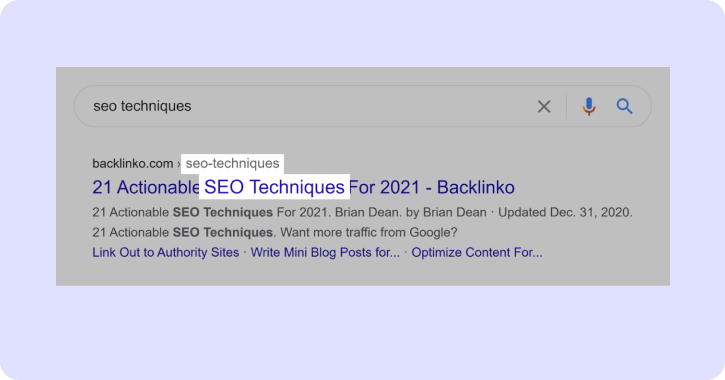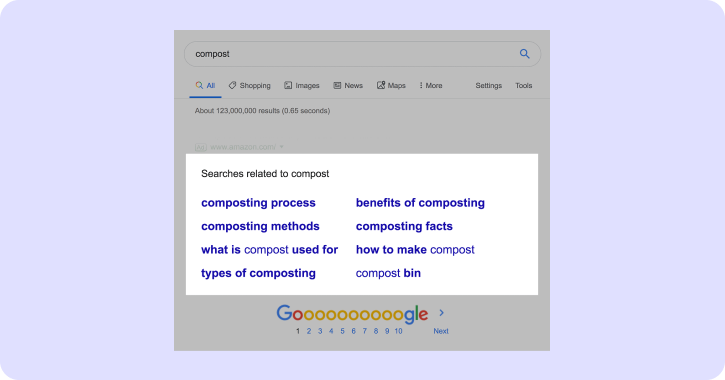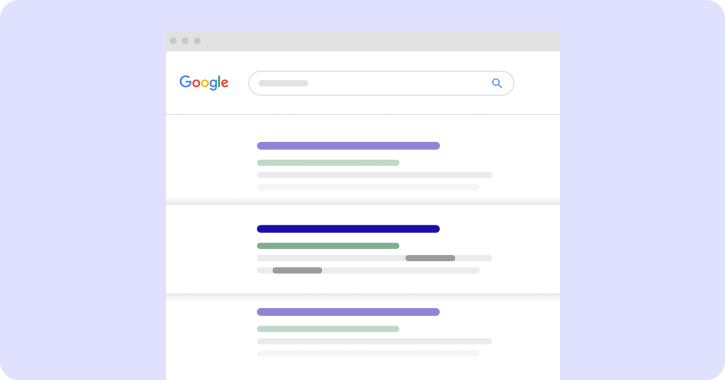Most people associate SEO keyword research with selecting individual keywords for use in website metadata such as title tags, meta descriptions, and H1 headers that help search engines understand the content of a website.
And while that’s still a part of it, keyword research has come a long way since the early days of SEO.
SEO keyword research is so much more than just finding individual keywords and keyword ideas to insert into our website copy.
Keyword research SEO is now an essential part of any comprehensive SEO strategy because it gives you the insights you need to understand what people are actually searching for when they go online.
This data can guide your content strategy, assist in selecting the most effective keywords for your website, and support your link-building efforts.
In short, effective keyword research is essential for a successful strategy. Businesses may also choose to work with an SEO agency for expert guidance.
But what, exactly, does keyword research involve? And how can you do it effectively?
To get started, it helps to explore keyword search engine examples to see how different tools generate keyword ideas and search volume data.
In this guide, we’re going to answer those questions and more about keyword research. We’ll start by taking a look at what keyword research is and why it’s so important. Then, we’ll give you a step-by-step guide to conducting your own keyword research.
After that, we’ll share some tips and tricks for making the most of your keyword data and even share some essential keyword research tools. So stay tuned!
What is Keyword Research and Why Does it Matter?
At its core, keyword research is the process of discovering what people are searching for when they go online.
Keyword research is an integral part of search engine optimization (SEO) because it helps you understand the language and topics your audience is searching for. With this data, you can develop content that’s more likely to appear in search results, drive more organic traffic, and ultimately grow your business.
When you conduct keyword research, you’re looking for patterns in search terms – words or phrases that have a high search volume but little competition from other marketers trying to target them in their SEO efforts. These are the kinds of keywords you want to hone in on if you want to get the most out of your SEO strategy.
Why Keyword Research Is the Foundation of Every SEO Strategy?

Keyword research is a vital foundation of any successful SEO strategy. It provides insights allowing you to see what people are looking for online, making it easy for you to produce content that meets those needs.
Having a good understanding of which keywords to target can help you attract more organic traffic to your website, as well as improve your ranking in search engine results pages (SERPs). In addition, keyword research SEO can also be used to inform other aspects of your SEO efforts, such as link-building and meta-tag optimization.
There are some important reasons why many businesses resort to SEO keyword research:
1. Understanding User Intent

Keyword research SEO helps you understand what people are looking for when they search online so you can create content that meets their needs and expectations.
You can answer questions, provide helpful advice, and target keywords that are more likely to draw in high-quality traffic.
2. Gaining Insights into Popular Topics
What’s trending?
Do NOT target yesterday’s keyword! It is outdated.The internet moves fast and communication between people is done in a heartbeat. So it’s essential to be up-to-date with the most relevant topics and words that are being typed on Google the most.
SEO keyword research can help you identify popular topics that you can use to write content that resonates with your target audience.
You can also keep an eye on emerging trends and capitalize on them before the competition does.
Researching keywords in your niche can uncover which topics are most popular among users and use this information to inform your content strategy.
3. Crafting Effective Titles and Descriptions

Knowing which keywords your audience uses will help you create more targeted titles and meta descriptions that give a clear understanding of what your content is about.
Your titles are important for attracting readers to your content, while meta descriptions help improve your click-through rate (CTR) in SERP features.
Therefore, if you don’t use the necessary keyword research in your titles and descriptions, it’s likely that your content won’t be seen by the people you’re trying to reach.
Tip: Make Your Titles and Descriptions Enticing
Start with the titles! Make sure to craft something that will grab the attention of your target audience and compel them to click through. Use keyword-rich language in your descriptions to provide a clear overview of what your content is about.
For example, if you’re writing a blog post about SEO, make sure to include the keyword “SEO” in both the title and description. This will help the search engine rank it accordingly.
And to make it interactive, you can incorporate adjectives in the title, such as “The Essential Guide to SEO” or “Everything You Need to Know About SEO.”
4. Optimizing Your Website for Specific Keywords

By targeting the right keywords, you can improve your search engine rankings and drive more traffic to your website.
Your website should also be optimized with these keywords, which means using them in the body text, titles, meta descriptions, and URLs. This will help search engine crawlers understand the context of your content and ensure that it’s easy for users to find in SERPs.
However, be mindful of SEO keyword cannibalization, which can occur when multiple pages target the same keyword, leading to internal competition and potentially lower rankings. Use them strategically in the body text, titles, meta descriptions, and URLs.
Additionally, employing white hat SEO techniques will help maintain the integrity of your optimization efforts.
5. Informing Your Link-Building Strategy

Knowing which keywords are most popular in your niche will help you identify potential link opportunities from websites that rank for those terms.
Collaboration and backlinks can help you increase your visibility and reach a larger audience. Plus, it will also give you an additional signal of authority, which can give your website a boost in the SERPs
Important tip: Remember not every page that ranks high is worth linking to, so make sure you only target high-quality websites with good domain authority.
Some websites use black hat backlink tactics, which can have a negative impact on your website’s ranking in the long run. So, be sure to use caution and conduct thorough research before building any links.
6. Gaining a Competitive Advantage
By keyword research process used by your competitors, you can gain insights into their SEO strategies and find new keywords to target in order to stay ahead of the competition.
For example, if your competitors are targeting certain keywords that you haven’t yet identified, you can use this information to build out your content strategy and develop content that is more likely to rank higher in Google search results.
Plus, marketing trend analysis and brand monitoring can also help you understand how your competitors are using their keywords.
Now that you know why keyword research SEO is so important, you need to know how to do it.
So, what steps are involved in conducting SEO keyword research? Let’s take a look!
How to Do Keyword Research: a Step-By-Step Guide

What goes into keyword research SEO?
Sometimes you can have the perfect topic but still have trouble getting it to rank in search engine results. That’s why keyword research is so important for SEO, since you need to figure out which phrases people are searching for when they look for information related to your topic.
And this is what leads us to step number 1 on the list.
Brainstorm and Make a List of Keywords Relevant to Your Business
Start by making a list of topics related to your business that people might be searching for. You can come up with 5 to 10 topic buckets and then start to look for specific keywords within each one.
For instance, if you own a home decor store, your topic buckets might include: “living room furniture”, “bedroom furniture”, “home office furniture” etc.
Remember to jot down your buyer personas as this will help you pinpoint the most relevant keywords.
If we take the example above, your buyer personas might include “single mom”, “recent grads”, or “first-time homeowners”.
Pay attention to monthly search volumes to estimate how many people search for each keyword. Use a keyword research tool to find this data.
We will cover this in more detail later.
Fill in Your Topic Buckets with Keywords
Once you have your topic categories and buyer personas, start populating them with relevant keywords. These are the phrases people are likely to type into Google when searching for your products or services.
For example, someone looking to buy a dog might type “buy a labrador retriever.”
It is important to include both short-tail and long-tail keywords:
- Short-tail keywords are one or two words and broad. They usually have high search volume but strong competition. Example: “home office furniture.”
- Long-tail keywords are three or more words and more specific. They have lower search volume but less competition, making them easier to rank for and more likely to convert. Example: “ergonomic home office chairs.”
Other keyword types to consider include:
- Question terms: Phrases starting with “what,” “where,” or “how.” Example: “How to choose the best home office desk.”
- Comparison terms: Phrases comparing two or more items. Example: “ergonomic office chair vs regular office chair.”
- Negative keywords: Words or phrases related to your topic but irrelevant to your business. Example: “free home office furniture” if you sell products.
- Head terms: Highly popular keywords with strong search volume and competition. Example: “home office furniture.”
Including a mix of these keywords ensures your content reaches the right audience while maximizing ranking potential.
Understand How Intent Plays a Role
Once you have your topic buckets and buyer personas, add relevant keywords people actually search for.
Include both:
- Short-tail keywords: Broad, high search volume, competitive. Example: “home office furniture.”
- Long-tail keywords: Specific, lower volume, easier to rank, higher conversion. Example: “ergonomic home office chairs.”
Other types:
- Questions: “How to choose the best home office desk.”
- Comparisons: “Ergonomic chair vs regular chair.”
- Negative keywords: Irrelevant searches like “free home office furniture.”
- Head keywords: Popular, competitive terms like “home office furniture.”
A mix of these ensures your content reaches the right audience and ranks better.
Research Related Keyword Terms
Look for related keywords to broaden your audience and improve content relevance. For example, if your main keyword is “home office furniture,” also target terms like “desk chairs” or “home office desks.” Using related keywords makes your content more comprehensive, informative, and likely to perform better in search results.
Tip: Leverage Google Autocomplete. As you start typing a keyword, Google suggests popular related searches. These suggestions can inspire content ideas, help uncover additional keywords, and guide your overall SEO strategy.
Tip: Consider Google’s Autocomplete Suggestions
Another great way to find related keywords is by using Google’s Autocomplete keyword suggestions.
Start typing in a keyword, and Google will automatically suggest related terms that people are searching for.
These can be used as ideas for content creation, or even as keywords you should target in your SEO strategy.
Use Keyword Research Tools
Using keyword research tools is another great way to find relevant keywords and phrases. These tools can help you identify the most popular search terms and even uncover hidden gems that your competitors might be targeting.
They also provide helpful data such as search volumes, keyword trends, competition levels, and more. This information can help you better understand which keywords are worth targeting and how competitive each keyword is.
Some popular keyword research tools include Ahrefs, SemRush, Moz, and Google Keyword Planner.
Ahrefs:
Ahrefs is a powerful keywords research tool that offers comprehensive data and insights. It can help you identify popular keywords, uncover related search terms, and see how competitive each keyword is.
Semrush:

Semrush is another helpful keyword research tool. In addition to providing keyword data, it also offers valuable SEO insights such as backlinks analysis, technical SEO audit and more.
Moz:
Moz is a great tool for keyword research, as it provides you with the data you need to create an effective keyword strategy. It can help you uncover long-tail keywords, understand search intent, and identify related search terms.
Google Keyword Planner:
This is a free tool that provides keyword data and insight. It can help you discover related keywords, understand search trends, and even estimate how much traffic each keyword might bring to your website.
Ubersuggest:
Ubersuggest is a free keyword research tool that offers helpful insights such as keyword difficulty, search volume, and more. It can help you find keywords that are easier to rank for and understand how competitive each keyword is.
By using these tools while considering intent, you can develop an effective keyword strategy for your content that will help you reach the right audience at
You can also use these tools to find long-tail keywords and related search terms to target in your content.
Overall, keyword research tools can save you a lot of time when it comes to selecting the best keywords. They can help you understand search intent and find related keywords to target in your content so you can drive more traffic to your website.
How to Ensure Your Keywords are SEO-optimized in 7 Steps
Creating your topic buckets is only the start of the process. You need to also make sure that your chosen keywords are SEO optimized in order to get the most out of them.
Follow these steps to ensure that each of your chosen keywords is SEO-optimized:
Using Google Keyword Planner to Cut Down Your Keyword List

Google’s keyword planner is a useful tool to help you cut down your list of keywords. It provides data on search volume and competition so you can easily identify which keywords are worth targeting.
You can combine the planner with Google Trends to see if any of your keywords are growing in popularity or declining over time. Google Trends is a great way to find unique keywords that might be worth targeting.
Prioritize Long Tail Keywords
Long-tail keywords are more specific search terms that may have lower search volume but are higher conversion rates. It’s important to prioritize long-tail keywords because they can be easier to rank for and give you better results.
Besides, during the initial stages of SEO, you should focus on low-competition keywords to increase your chances of ranking higher.
As you increase your site’s ranking, you can start targeting more competitive keywords.
Balancing On-Page and Off-Page SEO
To ensure your keywords are fully optimized, focus on both on-page and off-page SEO:
Goal: Combining on-page and off-page strategies creates a strong SEO plan that helps your website rank higher and attract more visitors.
Optimize for Voice Queries
Voice queries are becoming increasingly popular due to the growth of virtual assistant devices such as Amazon’s Alexa and Google Home. It’s important to optimize for voice queries because this is how people are using any search engine now.
When optimizing for voice queries, focus on natural-sounding phrases and use keywords that people would actually ask a virtual assistant. This will help you reach more people who might be looking for your content.
Optimizing Voice Search for Mobile:
Mobile search is a different beast than desktop searches. People use their phones differently and often rely on virtual assistants to answer their questions quickly.
When optimizing for mobile SEO, focus on shorter keywords. For example, instead of using “why is my PC light not turning on”, you can use “PC light is off” or “why is my PC light off”.
Also, use natural-sounding phrases that people would actually say, such as “My computer won’t turn on”. This will help your content show up in voice search results.
Analyze Your Keywords
Analyzing your keywords can help you understand how they are performing. You can use tools such as Google Search Console to analyze your keywords and determine which ones are bringing in the most traffic to your website.
There are also several things you need to consider regarding keyword analysis:
Monthly Search Volume
How many people are searching for a particular keyword?
This factor helps you understand the potential reach of your content. If you want to reach more people, you should focus on keywords with higher search volume.
You should also keep in mind the following regarding the search metric:
- Search Count vs. Users: It’s the total number of searches that matters, not the number of people searching. For example, one person might search a keyword 1000 times, while another searches only once.
- Fluctuations Over Time: Search volumes can change month to month. A high-volume keyword last month might not stay high this month.
- Traffic Potential: High search volume does not guarantee lots of website visits.
- Annual Average: Look at the yearly average of searches to get a more accurate picture.
- Country-Specific Data: Search volumes can vary by region. If targeting a specific country, always check the local search data.
Traffic Potential

Traffic potential is the estimated amount of visits that a keyword can bring to your website. It’s based on the competition and volume of the keywords.
It’s important to consider both the search volume and competition when analyzing keywords as these will affect how much traffic you can get from each one.
If you’re using Ahrefs, you can use the “traffic potential” metric to see how much-estimated search traffic you can expect from a keyword.
Important tip: search volume is NOT the same as the traffic potential.
For example, there can be two pages that rank for the same keyword, like “coffee filters.” However, after looking at traffic potential, one page may have a score of 100 while the other scores 500.
This shows that even if they rank for the same keyword, the page with higher traffic potential will likely bring more visits to your website. This is often because the higher-performing page uses related keywords that also rank well on SERPs, such as “buying coffee filters” or “biodegradable coffee filters.”
So when analyzing keywords for SEO, do not just focus on search volume. Consider traffic potential as well to get a clearer picture of which keywords can bring meaningful visits.
Keyword Difficulty
Keyword difficulty measures how hard it is to rank for a particular keyword in search engine results pages (SERPs). Using a keyword research tool, you may see metrics like domain authority, page authority, and the number of backlinks for ranking pages. These metrics help you understand how much effort it will take to outrank competitors.
A keyword with very high domain authority will likely require more investment in high-quality content and link-building to compete. Keep in mind that keyword difficulty can vary across search engines. What is challenging on Google may not be the same on Bing.
You do not need to target only high-difficulty keywords. Low-difficulty keywords can still drive traffic and help diversify your keyword portfolio. The best approach is a balance: target high-difficulty keywords but also include lower-difficulty ones. This strategy can improve indexing speed and gradually boost organic traffic.
Local Search Volume
If your target audience is local, you need keywords with local search volume. Unlike global search volume, this metric counts searches from a specific region or city. For example, if your business targets New York City, focus on keywords with local search volume relevant to that area. Tools like Ahrefs’ “Keywords Explorer” can help you find these local keywords. Once identified, you can optimize your content and website to attract more local visitors.
Cost Per Click
Cost per click (CPC) is the amount you pay for each click on your advertisement. It is important to consider CPC when selecting keywords because it affects your ad budget and campaign efficiency. High CPC keywords require higher conversion rates to make the investment worthwhile. Tools like Google Keyword Planner provide estimated CPC for any keyword, helping you prioritize the best options for your campaigns.
Study the Search Intent
Search intent is the goal a user has when entering a query in a search engine. Understanding this helps you create content that meets your audience’s needs and improves ranking potential. Knowing what people want allows you to design content that aligns with their expectations and increases the likelihood of engagement.
Focus on the following variables to better understand search intent:
- Type: Are they looking to buy, read, or watch something?
- Format: Do they prefer a list, infographic, tutorial, or another format?
- Focus: Are they searching for specific information on a topic?
- Timing: Do they need an immediate answer or have time to research?
- Location: Are their searches localized?
By analyzing search intent, you can create content that satisfies user needs while boosting organic traffic. Always consider the intent behind your target keywords to match content to user expectations.
Identify Your Parent Topic
When researching keywords, start by identifying the main topic they relate to, called the parent topic. This helps you understand the type of content and pages you need to create. For example, if your keywords are about “social media marketing,” the parent topic is “social media.”
Understanding the parent topic allows you to focus your content and improve your chances of ranking. Tools like Ahrefs’ “Content Explorer” can help identify parent topics for any keyword.
Key factors to consider in keyword research include search volume, traffic potential, keyword difficulty, local search volume, and cost per click. By analyzing these, you can choose the best keywords for your business and create content that meets user needs.
How to Master Keyword Research to Drive Results Faster

You might have already started with some basic keyword research SEO. But, if you want to drive better results faster and make your website more visible on search engine result pages (SERPs), you can take a few other steps.
Monitor Your Rankings
It’s important to monitor your rankings for the keywords you’ve identified to track progress and optimize your campaigns accordingly.
If your rankings aren’t meeting your expectations, you’ll know what to tweak or change.
Tools like Ahrefs’ Rank Tracker can help you monitor how your pages rank for different keywords and identify areas you need to optimize.
Understand the Buyer’s Journey Framework
Your potential customers go through a series of steps before making a purchase. Understanding the buyer’s journey framework can help you create content that meets their needs at each stage and convert more visitors into leads and customers.
A common and popular frame of reference is AIDA, which stands for attention (Awareness), interest (Interest), decision (Decision), and action (Action).
Awareness
The first stage of the buyer’s journey is awareness. Your potential customers are just beginning to identify a problem or need and are researching potential solutions.
For example:
If a potential customer might need software, they might enter “the best software for XYZ” into a search engine.
Interest
During this stage, visitors learn more about solutions that can help them solve their problem or need. They’re actively searching for content that can provide information and help them make informed decisions.
For instance, if a potential customer is researching software, they might search for “the top features in XYZ software.”
Decision
At this stage, visitors are gathering more information and comparing different solutions to determine which one best meets their needs.
For example, if a potential customer is looking for software, they might search for “XYZ software vs ABC software” or “XYZ Software reviews.”
Action
In the final stage of the buyer’s journey, visitors are ready to purchase a product or service.
For example, if someone is looking for software, they might search for “XYZ software pricing” or “buy XYZ software.”
By understanding the buyer’s journey framework and the type of content visitors need at each stage, you can create content tailored to their needs. This can help increase conversions and bring more leads and customers to your business.
Keep an Eye on Your Competitors
It’s important to do competitor keyword research to keep track of your competitors and the keywords they’re targeting. This can help you get insights into what works for them and identify gaps in their SEO strategy that you can take advantage of.
Tools like Ahrefs’ Site Explorer, Keywords Explorer, and Content Gap can help you measure their performance and identify keywords they’re ranking for that you aren’t.
Identify and Review Your Primary Keywords:
You should focus on one or two main keywords per page and use them to create topic buckets.
These primary keywords should be used in your page’s title, headings, body content, and meta descriptions.
By creating topic buckets, you can group related keywords together, making it easier to create targeted content that helps visitors find what they’re looking for.
It also helps search engine crawlers understand your content, which can improve rankings and increase visibility.
Remember to review your primary keywords often and adjust them as needed. Since trends and search queries, and behavior can change quickly, it’s important to stay up-to-date and optimize your keywords accordingly.
Optimize Your Content for Search Engines
Optimizing your content isn’t just about pleasing search engines — it’s about creating value for your readers. Your content should be useful, relevant, and easy to understand. If users lose interest after the first few sentences, your SEO efforts won’t matter. Keep them engaged by offering fresh insights, up-to-date information, and practical value.
To build credibility, follow Google’s E.A.T. principles — Expertise, Authority, and Trustworthiness:
- Expertise: Ensure your content is created or reviewed by someone with proven experience in the topic. For example, an SEO article should be written by a professional familiar with SEO best practices.
- Authority: Support your claims with data and references from reputable sources like Moz, HubSpot, or Search Engine Journal. Reliable citations strengthen your content’s authority.
- Trustworthiness: Always provide accurate, current information that readers can rely on. Outdated or misleading data harms both your audience’s trust and your search rankings.
By aligning your content with user needs and E.A.T. standards, you’ll boost visibility, build trust, and improve your site’s overall performance in search results.
Include Keywords in Title Tags
Ensure all your chosen keywords are included in the title tags and meta descriptions of your published content. This will help improve your SEO rankings significantly.
For example, if you’re targeting the keyword “SEO basics,” make sure to include it in the title tag of your content. This will help search engine crawlers better understand what your page is about and help it rank higher in the SERPs.
Title tags also play a very important role. The title tag should generally be no more than 60 characters in length; otherwise, it will get truncated in search engine results. This means that you should include your main keyword as close to the beginning of the title tag as possible.
Utilize Internal Links
Internal links help visitors move through your website more easily, leading to better engagement and a smoother user experience. They also assist search engine crawlers in understanding your website’s structure, allowing them to crawl and index your pages more efficiently. This process improves your search rankings and increases your visibility in search results.
Include internal links wherever they naturally fit within your content. For example, if you are writing about SEO basics, link to other pages on your website that provide more detailed information on related topics. This approach helps guide readers around your site and increases the chances of them finding the information they need.
When adding internal links, make sure they are relevant and not broken. Use descriptive anchor text so that both readers and search engines clearly understand the context of the linked page.
Add Keywords to Image Alt Text
Search engines can’t “see” images, so you should include your chosen keywords in the alt text of any images you use on your site. This will help search engine crawlers better understand the content on your page.
For instance, if you’re writing about SEO best practices and include an image, then you should master seo image optimization, using the alt text to describe the image’s content. This could be something like “How to Optimize Your Website for SEO” or “Best Practices for SEO.”
By adding your chosen keywords to the alt text, you can help give search engine crawlers the context they need to understand better what your content is about. This can potentially improve rankings and increase visibility in SERPs.
Use Keywords in URLs
Use keywords in the URLs for any pages or blog posts you create to help search engines understand what your content is about and rank it accordingly.
For example:
✅ www.example.com/seo-basics
❌ www.example.com/page?id=1234
Use descriptive keywords when creating URLs, as this can make your content more visible to potential visitors. Keeping URLs short and concise is also important, as this can help improve click-through rates from SERPs.
Focus on Quality Content
Above all else, focus on creating quality content that users actually want to read and share rather than keyword-stuffed articles that are of no use to readers. Search engines will appreciate it, too.
Things to keep in mind when writing content include grammar, readability, structure, and style. Aim to write content that is easy to understand, flows well, and provides helpful information. This can help drive organic traffic to your website and improve SEO rankings.
Don’t forget to optimize the content for keywords as well; this should be done after the content has been written to avoid detracting from its quality. This will help search engine crawlers identify what your page is about and rank it accordingly.
Keep The Text Natural
You don’t want to sound like a robot when writing content. It should be natural as if you’re talking to someone in person.
Remember that real people are reading your content, not just search engines.
Avoid overusing keywords or adding them in ways that make your sentences awkward or robotic. This can hurt readability and negatively affect user experience.
Instead, write naturally while weaving your keywords in logically and smoothly. Make sure all links are accurate, relevant, and lead users to the right destination. A natural writing style improves readability and strengthens both your SEO and your brand’s credibility.
Promote Your Content
Once you’ve published your content, promoting it to maximize visibility and reach is important.
Promoting your content through social media channels and other online networks can help draw attention to it while also helping you build relationships with influencers in your industry.
You could also consider running paid campaigns or promoting it through email newsletters.
Having a solid promotional strategy in place will help maximize the visibility of your content, which could lead to increased traffic and improved rankings in SERPs.
Keyword Search Engine Examples: Best Practices
Wrapping up, it’s important to understand that thorough keyword research SEO is at the heart of any successful SEO strategy. For your content to be found and ranked highly, you must find the best keywords & keyword phrases and use them appropriately.
Keep in mind the following:
- Always perform keyword research SEO before starting any project; know what keywords are most relevant to your content, and use tools like SEMrush or Google Keyword Planner to uncover related keywords.
- Don’t forget long-tail keywords; they may have lower search volume, but they can be more specific and have higher conversion rates.
- Study the search intent and keyword difficulty to ensure that the keywords you’re targeting fit the goals of your SEO strategy.
- Use internal links with relevant anchor text to help search engine crawlers understand the context of the page.
- Analyze the competition and determine how to differentiate yourself from them with different keywords.
- Consider the monthly search volume of keywords and use the ones that are most searched to maximize visibility.
- Utilize keyword modifiers such as location or negative words to further refine your search results.
- Focus on quality content and ensure your keyword usage is natural, not forced; use synonyms if necessary.
- Promote your content to maximize visibility and reach, as this can help improve rankings in SERPs.
Following the best practices outlined above ensures that your website has a solid foundation for SEO success!
Optimizing your content this way helps increase visibility, improve rankings, and attract more qualified traffic to your website.
Ready to take your content to the next level? Start optimizing today and focus on quality, credibility, and clarity to grow your audience and boost your SEO results.Choose wisely. Choose us!

